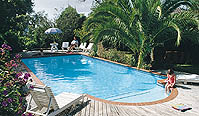"De-Klor"
Chlorine Reducer for Swimming Pools
 |
|
DAVIES "DE-KLOR" is used to reduce excess pool chlorine levels after superchlorination (shock treatment). Sunshine removes chlorine from outside pools. When indoor or stabilized outdoor pools are 'shocked' with high chlorine levels, DAVIES "DE-KLOR" must be added to remove excess chlorine. Periodic superchlorination is necessary to 'burn-out' body-borne contaminants and combined chlorine. With the use of DAVIES "DE-KLOR" indoor pools can be superchlorinated, treated with DAVIES "DE-KLOR" and can be used shortly after by swimmers. Some chlorine reducing products are toxic and hazardous and should not be used. The chemical make-up of DAVIES "DE-KLOR" is considered a safe, low-toxic material.
Directions
A pool is shocked with 10 ppm chlorine, some of which will be consumed during the 'burn-out' process. Good judgment must be exercised to prevent over treatment with DAVIES "DE-KLOR", because an excess will neutralize fresh chlorine added to the pool. It is better to slightly under treat with DAVIES "DE-KLOR", check the chlorine level, and repeat as necessary. For most pools, it is easier to measure volume amount of small quantities of DAVIES "DE-KLOR". The equivalent of 1/2lb. is 8 fl. oz. A good starting point is 6 fl. oz. of DAVIES "DE-KLOR" which will remove 4 ppm chlorine from 10,000 gallons of pool water. This is a good dosage level, and should be repeated as necessary.
| Pool Size | 10,000 gal | 20,000 gal | 40,000 gal | 60,000 gal |
|
"De-Klor" |
6 fl. oz. |
12 fl. oz. (3/4 lb.) |
24 fl. oz. (1 1/2 lb.) |
36 fl. oz. (2 1/4 lb.) |
DAVIES "DE-KLOR" should be mixed with water, prior to addition to the skimmer or deep end of the pool. Do not overtreat the pool with DAVIES "DE-KLOR" because any excess will neutralize fresh chlorine. It is better to undertreat slightly, than to chance overtreatment. A chlorine test kit should be used to monitor chlorine reduction. Between 2 and 4 hours, depending on circulation efficiency, is required for treatment.








